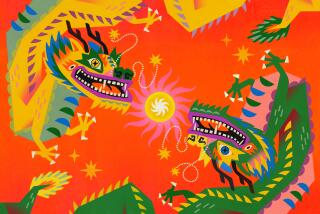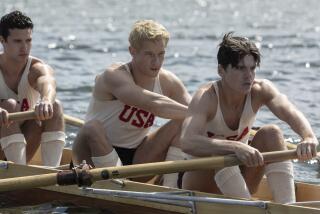Enter the Dragon
- Share via
PHILADELPHIA — Seven years ago, when Soc Thach was just 15, he trudged through jungles in the Mekong Delta in Vietnam, going along the long trail that would lead him to his new home in the United States. Now he and a group of other ethnic Cambodians living in and around Philadelphia spend some of what little leisure time they have on the Schuylkill River.
They are great fans and participants in dragon boat racing, an ancient mix of art, legend and athletics that spread from China to the rest of Asia more than 2,000 years ago. Thach and his fellow Khmers are part of an effort to spread the sport of dragon boat racing.
They are among the 2,500 paddlers who will be racing Thursday through Sunday in the World Dragon Boat Racing Championships, being held for the first time in the United States along Philadelphia’s Schuylkill River. Organizers expect up to 100,000 spectators to be on the banks of the Schuylkill, the tree-lined river famous for the rowing paintings by native artist Thomas Eakins. For Thach and his boat mates, it is an honor and a mission to participate.
“We knew we had to participate, if only to spread the word, both of the sport and our people’s plight,” Thach said. “It is a wonderful, wonderful sport.”
There is no denying that it is a picturesque one. Dragon boat racing is to normal rowing as, say, the Greek chorus is to the guy who gets to play Oedipus. It’s fancier but a lot more anonymous, and while you might be able to make a tiny mistake, you are a cog in a great team that takes every member meshing to be effective. Organizers say there are now about 40 million dragon boat paddlers worldwide, the bulk of them in China.
Each team has 22 members: 20 rowers in 10 rows of two, with a steering person standing behind, gondolier-like, and a coxswain who beats on a drum to keep strokes even. In short bursts, the rowers can do 100 strokes a minute and travel at 20 mph. The eight-person shells you may see in traditional rowing races are 25 feet long and light enough for a couple of people to easily lift. A dragon boat runs at least 40 feet long and weighs 500 to 1,800 pounds. Races are either 250, 500 or 1,000 meters long on a straight course in a variety of age and gender classes.
But while the race, here like in most every other sport, may go to the strong and swift, dragon boating is a bit more than that. Each boat is appropriately decorated with a dragon head and tail and, often, flags that represent either the nation or, more likely, the inner-soul of the group of rowers. The flag and shirts for Thach’s team, Khmer Kampuchea Krom Federation, for instance, have a map of the southern provinces of Vietnam, where the rowers are from. The Federation boat, made up of immigrants, is entered in the North American club races and does not represent either Vietnam or Cambodia officially, but the members hope this sporting venue will air their political message.
“We hope by focusing on racing that it brings our community together and we will then be able to tell the world about the plight of the Khmers in Vietnam, where they are oppressed for their ethnicity,” Thach said.
Although most of the competitors from 20 nations around the world--including China, Hong Kong and Taiwan, as well as Germany, Switzerland and England--are here primarily to win races, others also have missions they hope dragon boating will help. Four boats, for example, are being paddled by breast cancer survivors and are in their own special race category. Carol Lee Lindner, who is not a breast cancer survivor herself, saw organizing the Philadelphia-area team as a personal public service goal.
“I had heard about dragon boat racing five or six years ago and thought it might be fun,” said Lindner, 61. “We got together a bunch of women and just started doing it. We loved the teamwork aspect, and, frankly, with 20 in a boat, it is not as difficult as regular rowing.”
But then she read an article by medical researchers in Canada who thought that rowing, particularly the repetitive upper-body motion, would help breast cancer survivors build up their muscles in that area. According to Lindner, this ran counter to most doctors’ advice, which was that repetitive upper-body exercise would cause lymph damage in those who had had breast surgery.
“I put the word out this winter, and that word got around quickly. These are women who don’t want to sit around in clinics complaining about their chemotherapy treatments,” she said. “What they want is to ask, ‘How is your paddle hitting the water?’ or ‘Is your inside hand over the gunnel?’
“Now we want to get inner-city kids to do it. I have a Down syndrome daughter and she can do it,” she said. “Because there are so many people who have to work together, it is wonderful for that.”
Dragon boating is said to have started in Yueyang, China, where the poet-statesman Qu Yuan was thrown out of office by corrupt leaders more than 2,500 years ago. As a protest, he drowned himself in the Mi Lo River. Local fishermen went out to try to rescue him, or at least not have his body eaten by fish. They beat drums, pounded the water with paddles and threw rice dumplings in the water in hopes of appeasing the great water dragon to save Qu Yuan. The frenzied, many-rowered racing of the dragon boats is supposed to mimic this heroic effort.
The sport endured through the years primarily as local events throughout China. After World War II, Hong Kong developed the dragon racing into a modern sporting competition to lure tourists.
The frenzied splashing of the spectacle certainly attracted Glen Green when he first saw it. Green, a Naval Department engineer and a former world-class paddler from New Jersey, was in his kayak on the Schuylkill one day in 1982 when he saw this gang of rowers in an ornate boat.
“They were flying down the river. It looked great. They had started a revival of dragon boat racing in Hong Kong, and someone thought to interest Americans in it,” said Green, 55, who will be in the American 40-and-over dragon boat this weekend. “Only Jack Kelly answered their invitation.”
Kelly, who died several years ago running along the river, was a man-about-town in Philadelphia. He was the brother of Grace Kelly, the late actress and Princess of Monaco. Kelly, like his father, was a former Olympic rower. Philadelphia has long been a rowing center, with a string of Victorian boathouses along the Schuylkill starting at the base of its famous Art Museum. Premier races are held along the Schuylkill and the Cooper River in nearby Camden, N.J., where the U.S. National Rowing Championships took place last week.
Kelly thought dragon boating might be fun and took a bunch of his rowing friends to a local championship in Hong Kong. The promoters of the race sent a boat back with the Philadelphians in hopes of attracting them back, and the next year, the Americans won a silver medal. Meanwhile, folks from other countries got interested.
“It was quite a bit more elaborate and team-oriented than other paddling,” Green said. “As you get older, too, you want to continue rowing, but maybe can’t race as you did before. Doing it with 20 people keeps you going, and it’s fun to have that sort of team.”
Raymond Leung was a young adult Chinese immigrant in Australia when he saw his first dragon boat race in 1984 in Sydney’s harbor. It reminded him of his homeland, where the dragon is a symbol of power and majesty. Since the dragon was the symbol of the emperor and, by extension, his wealth and power, boys born in the year of the dragon are honored in China.
“Ooooh, it was so beautiful,” said Leung, now the Australian dragon boat team coach on his first trip to Philadelphia. “I was teaching judo but was looking for another sport. For a Chinese man, the dragon symbol is, well, hard to explain. But it brings the emotions of the past, of ancestors, of Chinese tradition.”
The boats Leung first saw were the traditional Hong Kong models, made of teak and more elaborately decorated than the sleeker ones used in international racing today. Those in Philadelphia this week will be Fiberglas and streamlined. (The host country provides all the racing boats to save on transportation costs. New dragon boats, made primarily in Germany and Canada, can run $6,000 to $10,000. The host committee is leasing 18 boats for the week.) While most of the racers talk of karma, tradition and ceremony, this is a serious World Championship for which they paid their own fares from Switzerland or Germany or China or Russia.
“Oh, yes, winning is the thing,” said Gary Carstens, president of the American Dragon Boat Assn. and a food-service salesman from Dubuque, Iowa.
“I grew up in Chicago and did some paddling,” said Carstens. “But, like many others, I heard about dragon boat racing, and it seemed like a good thing to learn teamwork by. Most of the good paddlers are in the Northeast or Northwest, but Dubuque is on the Mississippi, so we have some history there.”
Carstens and his board chose Philadelphia over Oakland and New York as the American host city because of its rowing tradition and the Schuylkill course, which is straight and wide.
“It’s got beauty and tradition and is clearly cheaper, for those who have to come here, than New York or the Bay Area, and tradition and cheaper is important for amateur athletes,” he said.
Carstens said that the Chinese delegation is hoping to make dragon boat racing a demonstration sport when the Olympics are held in Beijing in 2008. Philadelphia city officials think the World Championships will be popular here, predicting that those at the four-day meet will spend more than $7 million in the city.
“And maybe you’ll soon see people doing this on the river or lake everywhere,” said senior paddler Green. “Once they put this in the Olympics, you never know.”
More to Read
Sign up for The Wild
We’ll help you find the best places to hike, bike and run, as well as the perfect silent spots for meditation and yoga.
You may occasionally receive promotional content from the Los Angeles Times.






